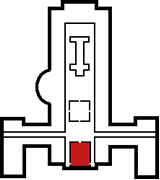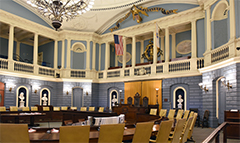Senate Chamber
(Third Floor)
 |
 |
Directly below the gold dome is the Senate Chamber. Forty senators conduct their business here, thirty-nine of whom sit around the circle of desks. The fortieth, the Senate President, sits at the rostrum under a golden eagle. Voting in the Senate is still done by voice.
Most of the room has changed from the original Bulfinch design, but the sunburst ceiling remains the same. Emblems symbolizing commerce, agriculture, war, and peace are located in the four corners of the ceiling.
High above the chamber are the public galleries. Marble busts of state and national figures stand in the wall niches, while busts of Presidents Washington and Lincoln sit behind the Senate President's desk. Near the visitors area is a bust of Marquis de Lafayette, a great friend of the American people, who visited the chamber on his way to lay the cornerstone for the Bunker Hill Monument in 1825.
Several presidents, including Jackson, Monroe, and Van Buren, were welcomed here. Angelina Grimke made political history in the chamber when, on February 21, 1838, she gave a speech advocating the abolition of slavery. She was the first woman to address a United States legislative body.
Notable facts
- Excerpt from Angelina Grimke’s address to the Senate:
- "I stand before you as a moral being, endowed with precious and unalienable rights, which are correlative with solemn duties and high responsibilities; and as a moral being I feel that I owe it to the suffering slave, and to the deluded master, to my country and my world to do all that I can to overturn a system of complicated crimes, built up upon the broken hearts and prostrate bodies of my countrymen in chains, and cemented by the blood and sweat and tears of my sisters in bonds.”
- The bust of Washington at the front of the Senate Chamber was at one time thought to be of Samuel Adams. The identity crisis was cleared up with the help of Lafayette, who commented, "That's the Washington I knew!"